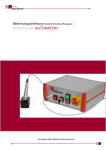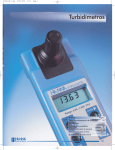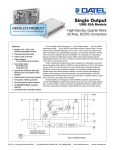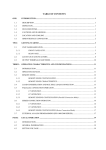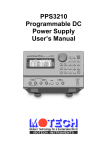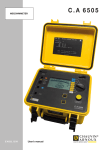Download Motech LPS 305 User`s manual
Transcript
LPS 305 Linear Programmable Power Supply User’s Manual CONTENTS 1. GENERAL INFORMATION........................................................................................................... 1 1.1 1.2 1.3 1.4 1.5 1.6 2. Introduction ................................................................................................................................. 1 Safety Considerations ................................................................................................................ 1 Options ........................................................................................................................................ 3 Accessories ................................................................................................................................. 3 Output Isolation .......................................................................................................................... 3 Specifications .............................................................................................................................. 3 INSTALLATION ............................................................................................................................ 5 2.1 2.2 2.3 2.4 2.5 3. Introduction ................................................................................................................................. 5 Initial inspection .......................................................................................................................... 5 Location and cooling.................................................................................................................. 5 Input power requirements .......................................................................................................... 5 Line fuse ..................................................................................................................................... 5 GETTING STARTED ..................................................................................................................... 6 3.1 3.2 Front panel controls and output terminals............................................................................... 6 LCD display message................................................................................................................ 8 REFER TO THE FIGURE B. ................................................................................................................... 8 3.3 4. Rear panel .................................................................................................................................. 9 OPERATION ............................................................................................................................... 10 4.1 4.2 4.3 4.4 Initial conditions ........................................................................................................................ 10 Control of output functions ...................................................................................................... 10 Enabling/Disabling the output .................................................................................................. 11 Overload protection of 5V or 3.3V output ............................................................................. 11 5. CALIBRATION ............................................................................................................................ 12 6. USER MAINTENANCE/SERVICE .............................................................................................. 15 6.1 6.2 6.3 6.4 Fuse Replacement ................................................................................................................... 15 In Case of Difficulties .............................................................................................................. 15 If the ERROR#2 shows on LCD ............................................................................................ 15 Using the RS-232-C Serial Interface ..................................................................................... 15 1. 1.1 GENERAL INFORMATION Introduction This section contains a general description of your power supply as well as its performance specifications. Information about options and accessories are also provided. The TPS-3025 series has been designed and tested according to EN-61010-1, Safety requirement for Electronic Measuring Apparatus. 1.2 Safety Considerations SAFETY PRECAUTIONS SAFETY NOTES The following general safety precautions must be observed during all phases of operation, service, and repair of this instrument. Failure to comply with these precautions or with specific warnings elsewhere in this manual violates safety standards of design, manufacture, and intended use of the instrument. The manufacturer assumes no liability for the customer’s failure to comply with these requirements. BEFORE APPLYING POWER ! Verify that the power supply is set to match the available line voltage and the correct fuse is installed. GROUND THE INSTRUMENT This product is provided with a protective earth terminal. To minimize shock hazard, the instrument chassis and cabinet must be connected to an electrical ground. The instrument must be connected to the AC power supply mains through a three-conductor power cable, with the third wire firmly connected to an electrical ground (safety ground) at the power outlet. For instruments designed to be hard-wired to the AC power lines (supply mains), connect the protective earth terminal to a protective conductor before any other connection is made. Any interruption of the protective (grounding) conductor or disconnection of the protective earth terminal will cause a potential shock hazard that could result in personal injury. If the instrument is to be energized via an external autotransformer for voltage reduction, be certain that the autotransformer common terminal is connected to the neutral (earthed pole) of the AC power lines (supply mains). The RS232 (option) Ground is connected with chassis ground, and therefore the operator must take care if the computer is also connected with other measuring devices prevent a short cut. FUSES Only fuses with the required rated current, voltage, and specified type (normal blow, time delay, etc.) should be used. Do not use repaired fuses or shout circuited fuseholders. To do so could cause a shock or fire hazard. DO NOT OPERATE IN AN EXPLOSIVE ATMOSPHERE Do not operate the instrument in the presence of flammable gases or fumes. KEEP AWAY FROM LIVE CIRCUITS Operating personnel must not remove instrument covers. Component replacement and internal adjustments must be made by qualified service personnel. Do not replace components with power cable connected. 1 Under certain conditions, dangerous voltages may exist even with power cable removed. To avoid injuries, always disconnect power, discharge circuits and remove external voltage sources before touching components. DO NOT SERVICE OR ADJUST ALONE Do not attempt internal service or adjustment unless another person, capable of rendering first aid and resuscitation, is present. DO NOT EXCEED INPUT RATINGS This instrument must be connected to a properly grounded receptacle to minimize electric shock hazard. Operate at line voltages or frequencies in excess of those stated on the data plate may cause leakage currents in excess of 5.0mA peak. SAFETY SYMBOLS WARNING The WARNING sign denotes a hazard. It calls attention to a procedure, practice, or the like, which, if not correctly performed or adhered to, could result in personal injury. Do not proceed beyond a WARNING sign until the indicated conditions are fully understood and met. CAUTION The CAUTION sign denotes a hazard. It calls attention to a procedure, practice, or the like, which, if not correctly performed or adhered to, could result in damage to or destruction of part or all of the product. Do not proceed beyond a CAUTION sign until the indicated conditions are fully understood and met. ! Chassis ground symbol Protective Conductor terminal Caution, risk of electric shock DO NOT SUBSTITUTE PARTS OR MODIFY INSTRUMENT Because of the danger of introducing additional hazards, do not install substitute parts or perform any unauthorized modification to the instrument. Return the instrument to a qualified dealers for service and repair to ensure that safety features are maintained. INSTRUMENTS WHICH APPEAR DAMAGED OR DEFECTIVE SHOULD BE MADE INOPERATIVE AND SECURED AGAINST UNINTENDED OPERATION UNTIL THEY CAN BE REPAIRED BY QUALIFIED SERVICE PERSONNEL. 2 1.3 Options Options 01 determine which line voltage is set at the factory. This information is on the rear panel label. Option 01: RS-232 Interface Option 02: Rack mount Shelf 1.4 Accessories Power cable Operation manual Fuse 1.5 Output Isolation The output of the power supply is isolated from earth ground. Either output terminal may be grounded or the output may floated up to +/- 240 Vdc (including output voltage) from chassis ground 1.6 Specifications TRIPLE OUTPUT LINEAR POWER SUPPLY UP TO 165 WATTS Model LPS 305 MAX. OUTPUT POWER 165 WATTS OUTPUT VOLTAGE Output Voltage 0 to +30V / 0 to -30V Setting Resolution Max. output voltage Dual tracking Fixed 3.3V / 5V 10mV +32V / -32V 0 to 30V 20mV Tracking deviation OUTPUT CURRENT Output Current 0 to +2.5A / 0 to -2.5A Setting Resolution 1mA Max. output current +3A / -3A Dual tracking 0 to 2.5A 3A Current limited approx. 3.3A 5mA Tracking deviation CONSTANT VOLTAGE CHARACTERISTICS (at rated output : 2.5A ) Line regulation(for change of AC 10%) 1mV 5mV Load regulation(for load change 0 100%) 2mV 10mV 1.5mVrms 2mVrms Ripple/Noise rms 3 Ripple/Noise (p-p) Transient Response 10mVp-p 20mVp-p 200s Typical 100ppm / ℃ Typical Temperature Coefficient CONSTANT CURRENT CHARACTERISTICS (at rated output : 2.5A ) Line regulation (for change of AC 10% ) Load regulation (for change from short to full load ) 15mA Typical 10mA Typical Ripple/Noise rms 1mArms Typical Ripple/Noise (p-p) 5mAp-p Typical 200 ppm / ℃ Typical Temperature Coefficient 2×16 LCD with backlit; Front Panel Status Display Announciators with beeper Voltage Accuracy* ( 0.2% of rdg +2 digits ) Current Accuracy* ( 0.5% of rdg +5 digits ) Common Mode Voltage Temperature ranges ±240Vdc Operating: 0℃ to 40℃, less than 80% RH; Storage: -40℃ to 70℃, less than 80% RH Dimensions (W × H × L) 8.4" × 5.2" × 15.7" Weight Approx. 18 lbs Cooling Fan Cooled Power Source AC 115V 10% OR 230V 10%, 47 to 63Hz Current Consumption Fuse Rating 2.88A / AC 115V or 1.48A / AC 230V 5AT / 250V for AC 115V, 2.5AT / 250V for AC 230V Options RS-232 User’s manual, power cord, fuse Accessories *For output less than 5% of rated output, add 5 digits to the accuracy specification RS232 Interface capabilities: 1. RS232C DCE interface: 9-pin D-SUB connector. 2. Port configuration: asynchronous 2400 baud, 8 data bits, 1 stop bits, no parity. 4 2. 2.1 INSTALLATION Introduction This section contains instructions for checking and mounting your power supply and connection your power supply to AC power. The power supply generates operating magnetic which may affect the operation other instruments. If your instrument is susceptible to operating magnetic fields, position it more than three inches from the power supply. 2.2 Initial inspection Your supply was thoroughly inspected and tested before shipment. As soon as toy receive it, remove it from its packaging case and check to make sure it has not been damaged during shipment, Check that there are no broken connectors or keys and that the cabinet and panel surfaces are free from dents and scratches, 2.3 Location and cooling Your power supply can operate without sacrificed performance within the temperature range of 0 to 40 ℃ (measured at the fan intake). The fan, located at the rear of the unit, cools the supply by drawing air in through the openings on the sides and exhausting it through the opening on the rear panel, Since the power supply is fan cooled, it must be installed in a location that allows sufficient clearance of 1 inch (25mm) is required on all sides for proper ventilation, 2.4 Input power requirements You can operate this power supply from a nominal 115V or 230(240) Vac single phase power source at 47 to 63Hz. You can check the line voltage setting of your supply of your supply by examining the label on the rear panel. 2.5 Line fuse You can operate this located behind the fuseholder on the QC input socket. To access the fuse, remove the power cord and pull out the fuseholder on the AC input socket. The current ration of the fuse is based on the line voltage setting of your supply. 5 3. 3.1 GETTING STARTED Front panel controls and output terminals Note:most soft keys have two functions. The first function of the key is function entry (i.e. + Vset, -Iset, Tracking etc.)The second function for the soft keys is data entry (ji. E. 0~9). REFER TO THE FIGURE A. (1) LCD display : Displays alphanumeric information with status annunciators. A detailed listing of descriptions is presented in section 3.2. (2) Power on/off : Powers on the unit. (3) + Vset(7) : + output control key used to display or alter the present voltage setting. Numeric entry key for number seven. (4) + lset (8) : + output control key used to display or alter the present voltage setting. Numeric entry key for number seven. (5) + ▲ (up) (9) : + output control key used to increase the voltage settings when the supply is in the CV mode or the current settings when the supply is in the CC mode. It will change voltage or current by 10mV, or 1mA respectively. If the key is pressed and held, it will continually increase the setting until it is released. Numeric entry key for number nine, (6) + ▼ (down) : + output control key used to decrease the voltage settings when the supply is in the CV mode or the current settings when the supply is in the CC mode by 10mV or 1mA per step. If the key is pressed and held, it will continually decrease the setting until it is released, (7) - Vset (4) : - output control key used to display or alter the present voltage setting. Numeric entry key for number four. (8) - Iset (5) : - output control key used to display or alter the present voltage setting. Numeric entry key for number five. (9) - ▲ (up) (6) : - output control key. The function is as same as positive channel. Numeric entry key for number six. (10) - ▼ (down) : - output control key. The function is as same as positive channel. (11) TRACK(1) : Mode control key which toggles the tracking mode on or off. (12) “0” : Numeric entry key for zero. (13) 5V/3.3V(2) : 5V or 3.3V output selecting key. Numeric entry key for number two. : 5V or 3.3V output control key which toggles the output on or off. Decimal (14) ”.” 6 point key. (15) Beep (3) : Beeper control key which toggle the beeper on or off. Numeric entry key for number three. (16) Enter : Enter the values on the display for the specified function and return the display to output-off mode or metering mode. (17) Clear : Used in conjunction with the numeric entry keys to clear partially set commands. Also returns unit to the previous mode. (18) output(on/off) : mode control key which toggles the output on or off simultaneously. (19) output terminal (RED) : This terminal is used to output +30V/+2.5A with respect to the COM1 terminal. (20) COM1 Terminal(BLACK) : The common terminal which is used for +30V/+2.5A output. (21) – output Terminal(WHITE) : This terminal is used to output +30V/+2.5A with respect to the COM1 terminal. (22) GDN Terminal (GREEN) : This ground(earth) terminal is connected to the main chassis. (23) COM2 Terminal(BLUE) : The common terminal which is used for 5V/3A or 3.3V/3A output. (24) 5V/3.3V Terminal )RED) : This terminal is used to output 5V/3A or 3.3V/3A with respect to the COM2 terminal. 7 1 7 3 8 4 9 5 6 10 LPS - 305 +VSET CV CC CV CC INDEP TRACK 5V 3.3V +ISET 7 8 -VSET -ISET 4 5 TRACK 1 + + 9 6 BEEP 2 3 ±OUTPUT 0 POWER ON I ±240 Vc MAX O OFF 2 5V/3.3V 24 COM2 COM1 23 11 12 22 14 21 13 20 16 19 15 FIGURE A 3.2 LCD display message REFER TO THE FIGURE B. 3 1 CV CC CV CC INDEP ALL OUTPUT OFF 20.00V -15.00V TRACK 5V 3.3V 2 4 FIGURE B 8 + 18 17 STATUS ANNUNCIATORS Position 1: Position 2: Position 3: Position 4: Indicator of CV mode or CC mode of + output (positive). It will flash when the output is enabled. Indicator of CV mode or CC mode of - output (negative). It will flash when the output is enabled. Indicator of the independent mode or tracking mode. Flashing cursor implies the unit is working normally. Indicator of the selected output 5V or 3.3V. It will flash when the output is on. ALPHANUMERIC LCD DISPLAY Normally LCD panel displays the preset or measured output voltage and current for both channels. When operating at the front panel, the programmed functions (e.g. + Vset, - Iset…etc), and The preset values (e.g. + Vset = 10.00V) will be displayed. Error conditions are also displayed on the LCD panel. 3.3 Rear panel REFER TO FIGURE C. (1) Input AC socket : AC receptacle for power cord (2) Fuseholder : Fuseholder for line fuse (3) RS-232C interface : 9-pin female DCE interface (4) Label : Indicator of input power requirements and fuse rating. (5) Voltage Selector :115Vac or 230Vac,-10%~+10%,50/60Hz 5 CAUTION: NO OPERATOR SERVICEABLE PARTS INSIDE. REFER SERVICING TO TRAINED SERVICE PERSONNEL. WARNING: DCE FOR CONTINUED PROTECTION AGAINST FIRE HAZARD , REPLACE ONLY WITH SAME TYPE AND RATING OF FUSE . FUSE RS-232C 3 2 1 4 FIGURE C 9 4. 4.1 OPERATION Initial conditions When AC voltage is applied, the power supply undergoes a self-test and disables all outputs by default. The display will show an “ALL OUTPUT OFF “ message along with the + Vset and – Vest values as shown in Figure 4.1. CV CC CV CC INDEP ALL OUTPUT OFF 0.00V -0.00V TRACK 5V 3.3V FIGURE 4.1 4.2 Control of output functions The power supply will accept programming values directly in volts or amps. All input values will be rounded-off to the nearest multiple of the resolution (typically 10mV or 1Ma) for that particular output. If the programming value is outside the valid range, an “INPUT REEOE“ message will be displayed on the LCD for one second and the power supply will return to the previous set value. When you press the +Vset, +Iset, -Vset, -Iset, the output selected (+output or –output) and the present setting for that function will be displayed. You can change setting using the numeric entry keys. Pressing the number keys will cause the present numeric setting to become blank and be replaced with the new numbers on the display .You can use the CLEAR key to erase previous keystrokes if you make a mistake. Pressing the ENTER key will enter the values displayed for the function indicated, initiate that function, initiate that function, and return the display to the output off mode or to the metering mode (output on) in which the measured numbers will result in retention of the previous values and return to the previous mode. You can also return to the previous mode at anytime by pressing the CLEAR key. The up/down arrow keys for each output are used to change voltage and current and current setting when the power supply is in the CV mode and in the CC mode respectively. NOTE The up/down keys change the LSB of the voltage or current (typically 10mV or 1mA) each time they are pressed. If the key is held down for more than 1 second, the power supply will automatically step up/ down until the key is released. The up/down step rate will increase if the key is held down for more than 2 seconds. The up/down step function can only be used when the power supply is in the metering mode. The function is disabled when the power supply is in the programming mode (i.e. when + Vset, +Iset, - Vset, -Iset or -Iset, is pressed). The power supply can be programmed by the numeric entry keys or the up/down step function even 10 when the selected output is disabled. 4.3 Enabling/Disabling the output The selected output channel can be turned on and off from the front panel. The output on/off key toggles both the +output and –output on and off simultaneously. The “.” key toggles the 5V or 3.3V output on and off. An output disabled by the output on/off key will be have as if it were programmed to zero volts. 4.4 Overload protection of 5V or 3.3V output When the 5V or 3.3V output current is approximately 20 percent above the current output rating or if the output is shorted, the overload protection circuit will be activated and the output will be disabled. To reset the output, first clear the condition that caused the overload then press the “.” (on/off ) key to enable the output to its previous state. 11 5. CALIBRATION Calibration steps: Equipment needed for calibration: DMM, such as Fluke model 45 or HP 34401A. Step 1: Simultaneously press the “8” and the “ -▼ ” keys on the Keypad and the following message will Appear on the LCD: CV CC CV CC INDEP +V Lo=09.487 ADC GET=01036 TRACK 5V 3.3V Step 2: Measure the DC voltage from the +output terminals (+ and COM1) with the DMM and key in the measured value (i.e. if the DMM shows 9.487V then key in 9.487) followed by the “ENTER” key. The following message will then appear on the LCD: CV CC CV CC INDEP +V Hi=29.798 ADC GET=03104 TRACK 5V 3.3V Step 3: Repeat step 2. Key in the measured value (i.e. if the DMM shows 29.798V then key in 29.798) followed by the “ ENTER “ key. The following message will then appear on the LCD. CV CC CV CC INDEP +I Lo=0.728 ADC GET=00903 TRACK 5V 3.3V 12 Step 4: Measure the DC current from +out terminals (+ and COM1) with the DMM and keyin the value (i.e. if the DMM shows 0.728A, then keyin 0.728 ) followed by the “ENTER” key. The following message will then appear on the LCD: CV CC CV CC INDEP +I Hi=2.491 ADC GET=02579 TRACK 5V 3.3V Step 5: Repeat step 4. Keyin the measured value (i.e. if the DMM shows 2.491A then keyin 2.491) followed by the “ENTER” key. The following message will then appear on the LCD: CV CC CV CC INDEP ADC GET=01039 -V Lo=09.624 TRACK 5V 3.3V Step 6: Measure the DC voltage from –output terminals ( - and COM1) with the DMM and keyin the measured value (i.e. if the DMM shows 9.624V then keyin 9.624) followed by the “ENTER” key. The following message will then appear on the CV CC CV CC INDEP ADC GET=03099 -V Hi=30.036 TRACK 5V 3.3V Step 7: Repeat step 6.Keyin the measured value (i.e. if the DMM shows 30.036V, then keyin 30.036) followed by the “ENTER” key. The following message will then appear on the LCD: 13 CV CC CV CC INDEP ADC GET=00200 -I Lo=0.624 TRACK 5V 3.3V Step 8: Measure the DC current from –output terminals ( - and COM) with the DMM and keyin the measured value (i.e. if the DMM shows 0.642A then keyin 0.642) followed by the “ENTER” key. The following message will then appear on the LCD: CV CC CV CC INDEP ADC GET=02503 -I Hi=2.418 TRACK 5V 3.3V Step 9: Repeat step 8. Keyin the measured value (i.e. if the DMM shows 2.418A, then keyin 2.418) followed by the “ENTER” key. The following message will then appear on the LCD: CV CC CV CC CV CC CV CC INDEP MOTECH LPS 305 Version 1.17 TRACK 5V 3.3V INDEP ALL OUTPUT OFF 10.00V -10.00V TRACK 5V 3.3V 14 6. USER MAINTENANCE/SERVICE 6.1 Fuse Replacement If the fuse is suspected of being defective, it should be inspected and, if necessary, replaced. To inspect or replace the fuse, please perform the following steps: (1) Disconnect the AC line cord from the unit to reduce electrical shock hazard. (2) Remove the fuse by sliding out the fuse holder. The fuseholder is beneath the AC Receptacle. Test the fuse for electrical continuity with an ohmmeter. (3) If the fuse is found to be defective, replace it with a replacement fuse as specified in the label on the rear panel. (4) Replace the fuse in the fuseholder and re-install. (5) Reconnect the AC power cord. NOTE: USE OF ANY FUSE OTHER THAN THE ONE SPECIFIED MAY CAUSE DAMAGE TO THE UNIT, POSE A SEVERE FIRE HAZARD, AND WILL VOID THE WARRANTY. 6.2 In Case of Difficulties This programmable power supply has been designed to be accurate, reliable, and easy-to-use. If you experience any difficulties during the use of the unit, please perform the following steps. (1) Re-read the operation instructions, It is very easy to inadvertently make mistakes in operation procedures. (2) Remove and test the fuse. The power supply will not function with an open fuse. If the preceding two steps fail to resolve the problem. NOTE: ATTEMPTED REPAIR, MODIFICATIONS, PERSONNEL WILL VOID THE WARRANTY. OR TAMPERING BY UNAUTHORIZED 6.3 If the ERROR#2 shows on LCD If the ERROR#2 shows on LCD, the calibration data in the EEPROM has been erased. The power supply needs to be recalibrated. Please process the EEPROM reset procedure below and follow the calibration procedures in the manual and enter the correct calibration value, the ERROR#2 will disappear as well as the beep sound. EEPROM Reset Procedure for LPS 305: Press the -Iset(5) key and the +▼ key simultaneously. 6.4 Using the RS-232-C Serial Interface This section describes hoe to set up the RS-232-C interface for remote control. The interface of TPT-3025 are designed in accordance with EIA (Electronic Industries Association) standard RS-232-C. Through its interface be TPT-3025 be remotely controlled and transmit its internal data to a hose computer. Command VSET1 VSET2 ISET1 ISET2 VOUT1 VOUT2 IOUT1 IOUT2 Description CH1 Voltage setup CH2 Voltage setup CH1 Current setup CH2 Current setup CH1 Voltage Readback CH2 Voltage Readback CH1 Current Readback CH2 Current Readback Example VSET1 5 VSET2 10 ISET1 1.5 ISET2 2.5 VOUT1 VOUT2 IOUT1 IOUT2 15 Command OUT TRACK STATUS CALI MODEL VERSION HELP BEEP VDD Description 0=+/- output off 1=+/- output on 0= independent 1= tracking from ch1 2= tracking from ch2 Working status(see note7) 0=Reset 1=begin calibration 2=input calibration parameter Display model no. Display version no. Display command list 0= beeper function off 1= beeper function on 0= digital output off 3= digital output 3.3V 5= digital output 5V Example OUT0 OUT1 TRACK0 TRACK1 TRACK2 STATUS CALI0 CALI1 CALI2 9.574 MODEL VERSION HELP BEEP0 BEEP1 VDD0 VDD3 VDD5 NOTE: 1. All RS232 commands are case-nonsensitivity ASCII codes. 2. Use async framing 8 data bits, no parity bit, 1 stop bit. 3. Bit rate=2400bps. 4. Every command string is terminated by CR or LF or BOTH (carriage return) 5. There is one command allowable in a command string. 6. A command string enters before “OK” prompt will be reject & no function. 7. STATUS operation explanation: After a TPT-3025 accept A “STATUS” command, it will display a decimal number in ASCLL Convert this decimal number to binary form each bit indicate a action/status: Bit 0: channel 1 0=CV 1=CC Bit 1: channel 2 0=CV 1=CC Bit 3,2: 00:independent 10:tracking to channel 1 11:tracking to channel 2 Bit 4: 0:digital output off 1:digital output on Bit 5: 0:digital output 5V 1:digital output 3.3V Bit 6: 0: +/- output off 1: +/- output on Bit 7: 0:nothing 1:digital output overload Bit 8: 0:fan off 1:fan on 16 Bit 9: Bit 10: 0:beeper function off 1:beeper function on 0:CC output compensated off 1:CC output compensated on 17 ZOM-305MI-1B






















